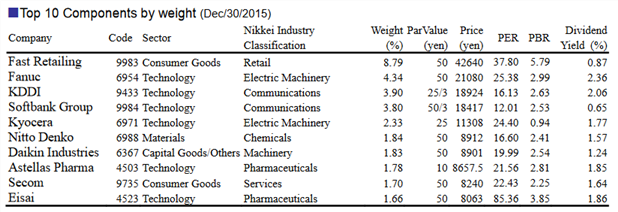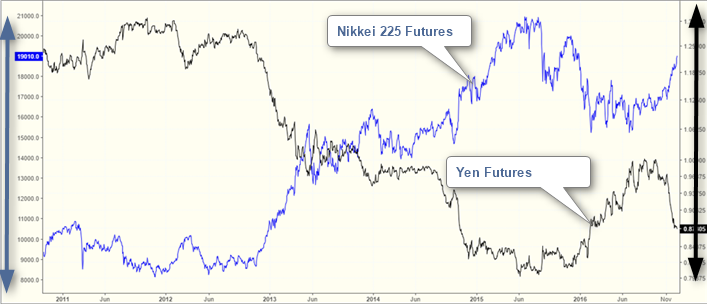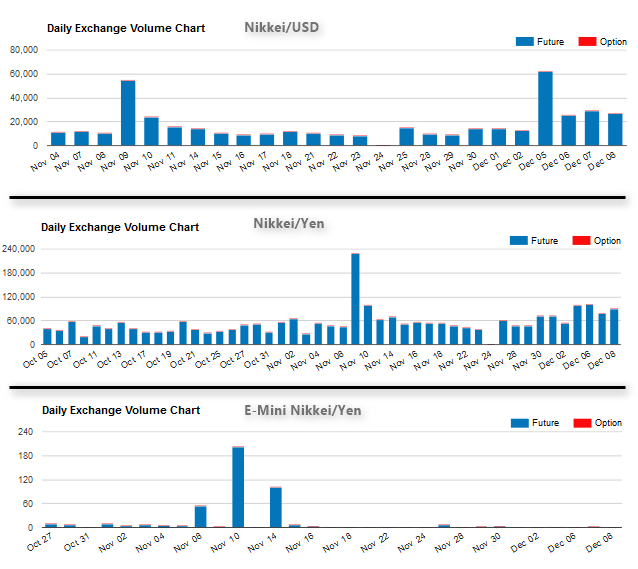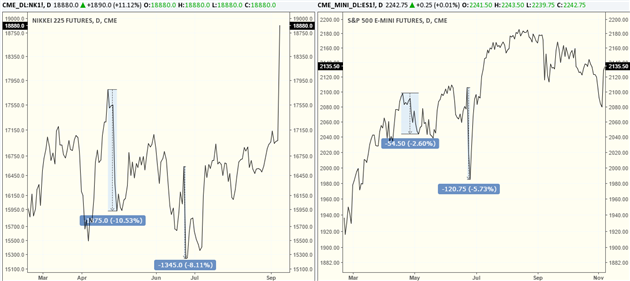The Nikkei futures are contracts that track the underlying asset, which is the Nikkei 225 stock index. The Nikkei 225 is also known as the Nikkei stock average which is a key stock market index for the Tokyo stock exchange (TSE). Trading the Nikkei 225 futures, traders can directly track the price movements of the underlying stock index. The Nikkei 225 futures were introduced to the CME exchange since 1990.
The Nikkei 225 index is comprised of 225 blue chip stocks trading on the Tokyo stock exchange. The Nikkei 225 is considered to be the barometer of the Japanese stock market. The most notable feature of the Nikkei 225 futures is that it can be traded in U.S. dollar and in yen. The Nikkei 225 futures contract are one among the many stock index futures available for trading via the CME Group.
The Nikkei 225 is the most popular stock index in Japan and holds similar weight to that of the Dow Jones Industrial Average in the U.S. in terms of its importance. The index commenced on September 7th 1950 and quickly grew to become one of the widely followed stock indexes from Asia, leading to many derivatives versions that track the stock index as a result. Futures contracts on Nikkei are just one of the many different derivatives that are available, besides ETF’s which are also widely popular. The main benefit of trading the futures on Nikkei comes with the fact that traders can day trade the Nikkei 225 contracts on margin with the ability to be long or short on the contracts.
What is the Nikkei 225 Stock Index?
The Nikkei 225 stock index tracks 225 blue chip companies listed on the Tokyo stock exchange. The index is a price weighted index and is similar to the Dow Jones Industrial Average which is also a price weighted index. This means that stocks with higher share price have a larger weightage in determining the value of the index. Japan’s leading stock index combines companies from various sectors and industries such as technology, financials, consumer goods, materials, capital goods and transportation and utilities. The Nikkei 225 undergoes an annual review with the components of the stock index being reviewed every October.

Top 10 components by weight on the Nikkei 225 Index
The most important aspect to remember about the Nikkei 225 Index is that most of the companies listed on the stock exchange are export oriented companies. Therefore the exchange rate of the yen plays a crucial role which evidently impacts the Nikkei 225’s index. When the exchange rate of the yen against the U.S. dollar appreciates, the Nikkei 2225 tends to weaken as a higher exchange rate hurts the exporters. Conversely, a weaker yen often results in higher prices on the Nikkei 225 index.

Nikkei 225 (yen) vs Yen futures
The above chart shows the correlation between the Yen futures (quoted in U.S. dollars) and the Nikkei 225 futures, quoted in yen. It is evident that the higher yen often leads to weaker Nikkei 225 prices and vice versa.
Nikkei 225 Futures Contract Specifications
The CME group offers the Nikkei futures which allow traders to participate in the price movements of the stock index. There are three types of Nikkei futures that are listed on the CME group: the mini-sized or e-mini Nikkei 225 (Yen), Nikkei 225 (dollar) and Nikkei 225 (Yen).
Among the three types, the Nikkei 225 Yen futures are the most active with an average of 80,000 contracts being transacted on a daily basis. Although the level of volume is relatively lower compared to the E-mini S&P500 futures, it allows for short term traders to enter and exit their trading positions with relative ease.

Comparison of trading volumes for the three types of Nikkei 225 Futures contract
The Nikkei 225 futures are cash settled.
Below is a brief summary of the Nikkei futures contracts
| |
USD denominated |
Yen-Denominated |
E-Mini Yen Denominated |
| Ticker |
NKD |
NIY |
ENY |
| Contract Size |
$5.0 x Nikkei 225 |
¥500 x Nikkei 225 |
¥100 x Nikkei 225 |
| Tick Size |
5 index points = $25 |
5 index points = ¥2500 |
10 index points = ¥1000 |
| Contract Months |
Quarterly (Mar, Jun, Sep, Dec) |
Standard 12 quarterly months, 3 serial months |
Quarterly (Mar, Jun, Sep, Dec) |
What are the differences between the Nikkei and S&P500 Futures?
The Nikkei and the S&P500 are grouped under the category of stock index futures and there are some similarities on the fact both the S&P500 and the Nikkei 225 futures track their respective underlying assets which are the stock indexes. Likewise, both the futures contracts are cash-settled meaning that there is no physical delivery of the underlying. But this is where the difference ends.
Here are the 6 main differences between the Nikkei 225 futures and the S&P500 futures.
#1 The Nikkei and the S&P500 futures track their respective stock indexes
The Nikkei 225 futures track the underlying asset, which is the stock market index in the Tokyo Stock Exchange. The Nikkei 225 index, considered to be one of the leading stock market indexes in Japan allows for traders to participate in the price moments via the futures markets. On the other hand, the S&P500 futures track the S&P500 Index in the U.S.
The key difference between the two stock indexes is that the Nikkei 225 Index is a price weighted index, while the S&P500 is a capitalization weighted index. What this means for futures traders is that while a company with a large weighting can influence the Nikkei 225 index, this risk is more broadly spread in the S&P500 index. As a comparison, a bad news from some of the top companies listed on the Nikkei Index could potentially pull down the pricing, on the other hand, a sector or industry wise bad news has the ability to pull down the S&P500 index.
#2 The Nikkei futures can be traded in Yen and USD. The S&P500 futures can be traded in USD only
Another key difference between the Nikkei and the S&P500 futures is that while you can trade both these contracts, with prices quoted in USD, you also have the option to trade the Nikkei 225 in Yen. Among the three types of the Nikkei futures contract, the Nikkei 225/Yen contracts are the most active, with the Nikkei 225/USD contracts coming in at the second place. With the S&P500 futures contracts, the pricing is available only in USD.
#3 Nikkei futures can be settled at CME or SGX
The Nikkei futures are unique from the S&P500 due to the fact that the contracts can be settled either at the Chicago Mercantile Exchange (CME) or at the Singapore Exchange (SGX). This is because of a mutual agreement between the two exchanges called the Mutual Offset System (MOS). However to take advantage of this, traders must designate a trade as an MOS for it to be cleared at the SGX. The MOS simply enables traders to open a trade at one exchange and settle it at another exchange. Depending on the type of contract you trade, the MOS allows traders access to lower performance bond and benefit from spread margining.
The S&P500 futures on the other hand are settled only at the CME exchange.
#4 The E-mini S&P500 futures are more popular than E-mini Nikkei futures
As far as the mini-sized futures contracts are concerned, the E-mini S&P500 futures are more popular than the Nikkei 225 e-mini futures, where volume in comparison is very low. This means that when it comes to margin requirements, the E-mini S&P500 futures command a lower margin or performance bond requirements.
For the Nikkei futures, the standard Nikkei 225/USD or the Nikkei 225/Yen futures are the more popular contracts having adequate volumes for day traders to trade with relative ease.
#5 The E-mini S&P500 futures has a lower tick size compared to the Nikkei futures
The minimum tick size for the E-mini S&P500 futures is 0.25 index points, with a value of $12.50. A full one point move in the E-Mini S&P500 futures is equal to $50. This is more manageable for the average day trader. On the other hand, if you compare the Nikkei 225 USD denominated futures contract, the minimum tick size is 5 index points valued at $25.

Nikkei 225 Futures are more volatile than the S&P500 futures
Needless to say, the Nikkei 225 USD denominated futures contracts are more volatile and can result in sharp intraday movements, while on the S&P500 E–mini futures contracts; the price action is a bit more manageable.
#6 The Nikkei 225 futures are influenced by the yen’s exchange rate
The Nikkei stock index in general is greatly influenced by the yen’s exchange rate. A weaker yen is often preferable for Japan’s export oriented economy and this is visible as a weaker yen often translates to the higher Nikkei index. Due to the fact that the yen is categorized as a safe haven currency, any geo-political uncertainty often sends traders to buying the yen. This in turn tends to have a negative impact on the Nikkei futures. As a result of this relationship, the Nikkei 225 index is influenced not just by the components listed on the exchange but also the broader global stability and outlook.
In comparison, while the S&P500 index does weaken during heightened uncertainty, the factors influencing the price of the S&P500 index is usually a lot more predictable, mostly on domestic factors and the broader outlook for the U.S. equity markets.
The above six differences between the Nikkei 225 and the S&P500 futures should help the trader to understand which of the two futures contracts are more ideally suited to trade. Bear in mind that there is no straight forward answer as to which of the two is the best as it depends on factors such as the trading capital and more importantly the interest in the markets. For someone who prefers to keep an eye on the Japanese stock index and is not intimidated by the volatility that it offers, trading the Nikkei 225 futures might be ideal. But on the other hand, for a day trader who prefers the calm and predictable nature of the S&P500 index will find the E-Mini S&P500 futures a more better asset to trade.









 Intro to Futures
Intro to Futures 
